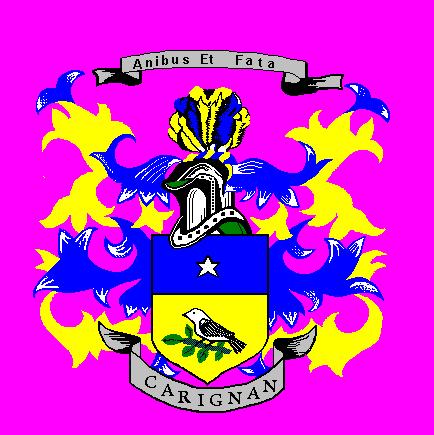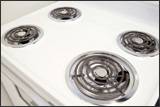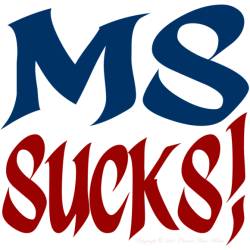|
__________________________________

Facts
About The Carignan Name
THE CARIGNANS OF AMERICA Bourbeau or Carignan?
It was at the time when Jacques Cartier discovered Canada that Francois the First decided
that all the French people should have a given and a family name in the future. Before the generalization of this phenomenon
there were a period of hesitation about this for at least one century. Some who chose a name would often change it shortly
afterwards, and one would see even in the families where there were five or six brothers each one adopted different family
names.
Also, was it not really surprising to know that none of the Carignans came to Canada as an immigrant?
After doing some researching, I discovered that the original name of our Carignan family is a very old French name used in
the legal acts for centuries by this family of Poitou who gave from the father to sons a series of clerks, and of Royal Notaries
under the name of Bourbeau.
This Bourbeau family, one in particular lived in a Protestant town of La Rochelle, at
the time when the Cardinal Richelieu had it almost completely destroyed in 1628. After a long reign, Richelieu got to love
the soil where the walls of this fortified town stood, and had
the catholic faith returned to La Rochelle. Thus, did the
father of our ancestor Bourbeau marry his first wife in the Protestant Temple? Since he remarried a second time he returned
to the catholic faith, and except for the oldest son Elie who was baptized at the Temple,
all the rest of the descendants
were baptized in the religion of Rome. (catholic)
We speak of families with numerous original names. It seemed that
the Bourbeau's were not too far to hold a record with the following original names: Bourbeau, Bourbel, Bourbelle, Villeneuve,
Lacourse, Carignan, Verville, and Beauchesne. Here are the explanations
of each of these names:
VILLENEUVE: The walls of La Rochelle once hugged the "new town" which faced in the East direction.
One member of the Bourbeau family took it as a family name. Villeneuve means NEW TOWN.
LACOURSE: Our ancestor Pierre Bourbeau came to establish himself in Canada, and since he
became a "bushranger" we surnamed him Lacourse. LACOURSE means coureur de bois, BUSH RANGER. CARIGNAN: A very strange phenonomen.
The son of Pierre Bourbeau chose to be named after his grandfather's maternal name which in reality was known as Besnard. VERVILLE:
Here, It seemed that one of Pierre Bourbeau's sons who possessed a plot of land to construct a church at Becancour asked to
be buried under the proper altar with his head "turned towards the town". VERVILLE means TOWARDS THE TOWN.
BEAUCHESNE:
The youngest son of Pierre Bourbeau who inherited the paternal land at Becancour became famous because this property is indeed
constituted almost entirely by a "forest of oak trees". His oldest brother who was a ship builder at Quebec told everybody
if one desired beautiful oak trees all one had to do was visit his brother in Becancour. This is how BEAUCHESNE meaning "beaux
chenes- "BEAUTIFUL OAK TREES" got his name.
As for BOURBEL and BOURBELLE, the custom in France was in a certain case that a young man by the name of Bourbeau chose to
take the name of BOURBEL, and the women feminized the name of
their husbands to BOURBELLE.
While counting
names, one found himself in the presence of a Bourbeau, Pierre saw his name take five different surnames in New France. Thus,
we are the Bourbeau descendants of Pierre Bourbeau dit Lacourse who was the last one born on August 22, 1648 in La Rochelle.
Since Pierre had the advantage of attending the communal schools, and of living with the Jesuits he knew how to read and write,
and at the age of 14, he embarked for Quebec. Once he arrived, he went to see his brother Elie at Cap-de-la-Madeleine where
he was confirmed at the age of 16. From 1664 to 1675, he lead an active life. As he cleared land, he was also known to be
a cultivator, then a carpenter, and at first when he became a guide in the forest he interpreted with the Indians, and traded
for furs. Then he became an explorer and a bush ranger which was how he received the name of Lacourse. He travelled from Boston
to Sault Ste. Marie, and at the age of 25, he sold some of his materials to Louis Jolliet who was
getting ready to descend
the Mississippi River in 1673.
In 1675, his mother Marie Noyron died leaving him 100 pounds. Happily to
have received this sum he purchased land on the banks of a river at Becancour, and built a home for himself and his love one
Anne Besnard whom he married in 1676. Like many others, marriage life quieted him down, and he died in Becancour in 1707,
he was a father of twelve children whom four of his sons are known as Pierre Lacourse, Louis Carignan, Pierre Verville and
Joseph Beauchesne. Let us go back now to the one who interest us in particular Louis dit Carignan. His name of Carignan came
from his grandfather's maternal side. His grandfather was a Corporal in charge of the garrison in Trois-Rivieres. At last,
the Regiment of Carignan who came here under Jean Talon's orders in 1665 was called back to France at the end of its' engagement.
The arrival of this prestigious Regiment made great noises in the colony, and the sight of a
Corporal, chief of the garrison
in Trois-Rivieres made some believed that he himself behaved as one of the soldiers of the Regiment. The original name was
Besnard dit Carignan.
Louis was born and baptized on January 26, 1693. Once he became a man, he realized without
any doubt that Carignan was a name which once held such glory in the colony, and it was a name which his grandfather took,
and it was a name which suited him as well. This was why
he became Louis Bourbeau dit Carignan. He married under the name of Carignan the first time at Quebec in 1717, the second
time in 1732, and the third time in 1745. Louis was a ship's carpenter, and he used a lot of oak trees. It was him who informed
all other constructors that his brother Joseph from Becancour had beautiful oak trees, a forest full of such beautiful trees.
Our ancestor Louis who lived all his life in Quebec, the father of ten children, died on October 28, 1762 at the age of 69.
While he was a ship's carpenter he had the reputation of being rather skillfull, but even finicky at times, and had a tendency
to want to settle all of his disputes in court. Do certain Carignan who are stubborn and known as perfectionists perhaps find
that they possess some of Louis' traits? How did those double family
names disappear? It seemed that one of the directive came from the clergy, in hope to simplify the officials acts by implying
one to use but one name instead of two or three which the people of that era possessed. Particularly in Becancour, Father
Louis-Stanislas Malo had the good will to make sure that all those extra family names disappeared. The following information will explain why the family finds itself still with five different
branches descending from Pierre Bourbeau in Canada: Bourbeau, Lacourse, Carignan, Verville, and Beauchesne. One must not think
however since these different original names were fixed definitively for a long time now because in Becancour Father Malo
directed his parish from 1849 to 1883, and it was only during that time that many disposed of their extra last names which
was not so long ago. The last of the Bourbeau's who was baptized Bourbeau dit Carignan was Jean-Evangeliste. All of his descendants
they use but the name of Carignan. In the genealogical registry which is offered with this document it
is possible to trace all of your ancestors as far back as Pierre Bourbeau dit Lacourse. The name has changed
over the centuries however, we are equally proud of being the Bourbeau's and the Carignan's.
__________________________________

Carignan-Salières Regiment
Carignan-Salières Regiment, of some 1100 strong, sent from France in
June 1665 to curb the devastating attacks of the IROQUOIS on Canadian settlements. By November a chain of forts had been built
along the Rivière RICHELIEU, blocking that main invasion route. When peace negotiations proved futile, a foolhardy midwinter
expedition was mounted: approximately 600 of the troops and 70 Canadians invaded the Mohawk canton in February 1666. Some
of them were ambushed, but no harm was done to the enemy. Some 60 more of the French perished during the retreat to Canada.
In September the regiment again invaded the Mohawk country, found the villages deserted, and burned them and the surrounding
cornfields. In July 1667 the Iroquois finally came to terms. The regiment was recalled to France in 1668, but some 400 officers
and men chose to remain and settle on seigneuries along the Rivière Richelieu, greatly strengthening the colony's defences,
military ethos, and economy.
__________________________________
43 Interesting Facts
About Canada
1.Kanata is the St. Lawrence-Iroquoian word for "village" or "settlement."
2.“O Canada,” originally named “Chant national,” was written by Adolphe-Basile
Routhier (French lyrics) and Calixa Lavallée (music) and first performed in Quebec City in 1880. The song was approved by
the Parliament of Canada in 1967 as the unofficial national anthem and adopted officially on July 1, 1980.
3.The border between Canada and the United States is officially known as the International Boundary. At
5,525 miles, including 1,538 miles between Canada and Alaska, it is the world's longest border between two nations.
4.The Canadian motto, A Mari Usque ad Mare, means "From sea to sea."
The Canadian flag is known as The Maple Leaf or l'Unifolié

5.Although Nova Scotia was granted the British Empire's first flag by King
Charles I in 1625, Canada did not have a national flag until February 15, 1965, when its maple leaf flag was adopted by its
parliament. Before that, the red ensign, a British maritime flag, was in general use.
6.At 3,855,103 square miles, Canada is the second largest country in the world, behind Russia.
7.Its population density is 8.6 people per square mile, making Canada the ninth-most sparsely populated
nation in the world.
8.The average life expectancy at birth for a Canadian is 81.16 years, the eighth highest in the world.
The United States ranks 46th, at 78.14 years.
9.The east coast of Canada was settled by Vikings around the year A.D. 1000. Archaeological evidence of
a settlement has been found at L'anse aux Meadows, Newfoundland.
10.Snorri, the first North American child to be born of European parents (Thorfin and Gudrid), was born
in Vinland around A.D. 1000.
11.Newfoundland was the first part of Canada to be explored by Europeans. Ironically, it was the last
area to become a province, in 1949.
12.In 1642, a group of religious mystics from France were inspired by a vision to build a missionary city
in the Canadian wilderness. Led by Paul de Chomedey de Maisonneuve and an Ursuline nun name Jeanne Mance, they founded Montreal.
13.According to the 2001 census, 42.6% of Canadians are Roman Catholic, 23.3% are Protestant, and 16%
claim to have no religion.
14.Alert, in Nunavut territory, is the northernmost permanent settlement in the world.
15.Canada became a country on July 1, 1867, when the British North America Act was passed by the British
Parliament.
16.The Mounted Police were formed in 1873, with nine officers.g In 1920, the Mounted Police merged with
the Dominion Police to become the famous Royal Canadian Mounted Police, an organization that now has more than 28,000 members.
17.While ice hockey is Canada's most prevalent sport, lacrosse is the country's official sport.h The modern
game of ice hockey was developed in Canada, based on games that have been played since the tenth century. The rules were first
published in the Montreal Gazette in 1877.
Basketball has become popular around the world since being invented by a Canadian

18.Canadian James Naismith invented basketball to give his physical education
students at the YMCA Training School in Springfield, Massachusetts, an indoor team sport to play during the long winters.
19.The capital city, Ottawa, was originally named Bytown after Colonel John By, who headquartered there
while building the Rideau Canal to connect the Ottawa River with Lake Ontario.
20.Canada has the longest coastline of any country in the world at 151,600 miles.
21.The regent of England, currently Queen Elizabeth II, is the Canadian head of state.
22.North America's earliest undisputed evidence of human activity, 20,000-year-old stone tools and animal
bones have been found in caves on the Bluefish River in northern Yukon.
23.North America's lowest recorded temperature was -81.4 degrees Fahrenheit (-63 C) at Snag, Yukon Territory,
on February 3, 1947.
24.Canada is known as the home of large animals like the moose and grizzly bear, but it is also home to
about 55,000 species of insects and about 11,000 species of mites and spiders.
25.Canada contains 9% of the world's renewable water supply.
26.The official languages of Canada are English and French. Throughout Canada's history up to the current
time, there have been conflicts between English and French-speaking Canadians.
27.Tensions between French Canada and English Canada reached a head in October 1970, when the Front de
Liberation du Quebec (FLQ)—a terrorist organization that had bombed cities, robbed banks, and committed a number of
other crimes—kidnapped the U.K. Trade Commissioner, Richard Cross. The army put an end to the revolt and arrested several
hundred suspects.
28.In 1527, John Rut of St. John's, Newfoundland, sent a letter to King Henry VIII—the first letter
sent from North America.
29.Charles Fenerty, a poet from Halifax, Nova Scotia, was the first person to use wood fibers to make
paper. He started experimenting in 1839 and produced paper from wood pulp in 1841.
Thomas Ahearn of Ottawa invented the electric cooking range in 1882

30.Canadians have made many important inventions, including Kerosene, the
electron microscope, the electronic organ, insulin, the IMAX film system, the snowmobile, and the electric cooking range.
31.Canada is a major producer and consumer of cheese. In 1997, Canadians produced 350,000 tons of at least
32 varieties of cheese and ate an average of 23.4 pounds per person, with cheddar being the most popular.
32.Many famous authors have come from Canada, including Lucy Maud Montgomery (Anne of Green Gables), Margaret
Atwood (The Handmaid's Tale), and Alice Munro (Lives of Girls and Women).
33.A black bear cub from Canada named Winnipeg (or “Winnie,” for short) was one of the most
popular attractions at the London Zoo after it was donated to the zoo in 1915. Winnie became a favorite of Christopher Robin
Milne and inspired the stories written by his father, A.A. Milne, about Winnie-the-Pooh.
34.The Moosehead Brewery in Saint John, New Brunswick, turns out 1,642 bottles of beer per minute.
35.Guy Lombardo of London, Ontario, first heard “Auld Lang Syne” as a teenage musician, when
he and his brothers toured the rural areas that had been settled by Scots around his hometown.
36.Canada has made a significant contribution to rock and roll, beginning with “Sh-Boom” by
the Crew-Cuts in 1954.i Other famous Canadian rock-and-rollers include Paul Anka, Neil Young, the Guess Who, Bachman Turner
Overdrive, Steppenwolf, Avril Lavigne, Rush, Bryan Adams, and Barenaked Ladies.
37.Cryptozoologists claim that Canada is the home of several cryptids, including Sasquatch, a giant sloth-like
creature known as the beaver-eater, a cannibalistic wildman named Windigo, and a number of lake monsters, such as Ogopogo
in Lake Okanagan, British Columbia.
38.The natives of eastern Canada tell several stories of a mythical giant named Glooscap, who carved out
many of the region's natural features to help him overcome his evil twin brothers. It is believed that these Glooscap stories
might be the origin of many of the Paul Bunyan legends.
39.The world's strongest current is found in the Nakwakto Rapids at Slingsby Channel, British Columbia.
The current has been measured at speeds up to 18.4 miles per hour.
Galaxyland at the West Edmonton Mall is the world's largest indoor amusement park.

40.The West Edmonton Mall in Edmonton, Alberta, was once the world's largest
shopping mall. It now ranks fifth, but it still contains the world's largest indoor amusement park.
41.Alberta has 50% of the world's supply of bitumen.
42.The CN Tower in Toronto was the world's tallest free-standing structure until it was eclipsed in 2007.
43.Manitou Lake on Manitoulin Island in Lake Huron is the world's largest lake within a lake (41.1 square
miles).
__________________________________

|

